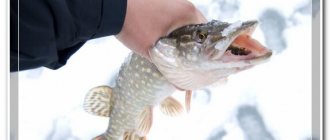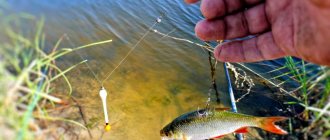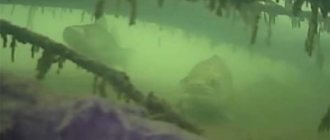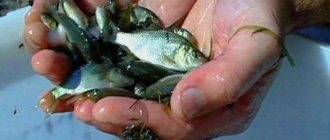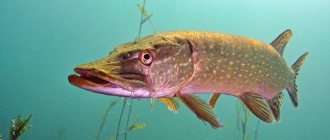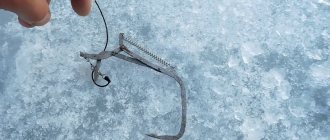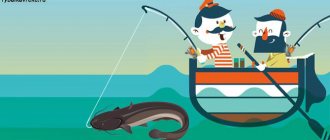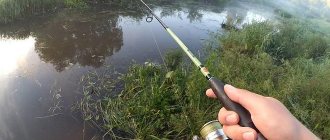Fishing with live bait from the shore - equipment
You can catch pike perch from the shore or from a boat. It is recommended to use a donkey. An indispensable condition for productive fishing is the current. The fishing technique is designed only for the fact that the fish, having become interested in the bait, will definitely swim up to it. The main thing is to choose the right place.
For ease of fishing, beacons - sound or light - are used.
The following can be used as live bait:
- roach;
- bleak;
- gudgeon.
They use predator rigs for hunting pike perch. It is better to use several spinning rods at once. They are placed along the shore and thrown in different directions. The capture of area thus increases.
Equipment:
- The rod should be fast action, rigid, up to 2.5 m.
- The load is 60 g, but it is advisable to take into account the strength of the current and adjust it on the spot. The load must ensure the stability of the gear.
- Hooks - No. 10. You can install doubles and even tees.
- A rocker arm is a branch made of wire (0.5 mm), with rings located at the end. Bend the third at an angle of 90º, twisting the spring out of it 2 turns. This device will help ensure more lively game of live bait. And if necessary, it will move the leash away from the first line. This will prevent it from getting tangled when casting.
- leashes , but you can also use strong fishing line.
- Reel with spool 2500 - 3000.
- Fishing line and braided cord 0.4 mm.
Here you will find a similar article on how to rig a fishing rod.
Catching pike perch with live bait using a float rod
The float rod is a classic.
It is convenient in that it makes it possible to fish with equal success in a reservoir adapted for fishing, and not so well:
- in driftwood;
- thickets of trees;
- algae
Pike perch prefers to hunt, mainly at night. He attacks his prey almost with lightning speed. But the bait should only be live, otherwise he will not be interested in it.
Rod
It is better to take a telescopic rod (length 4-6 meters). With a short rod, it will be difficult to make a long cast. If it is too long, it will be difficult to maneuver when biting.
You must have in your arsenal:
- reel seat;
- inertia-free reel, number 2500-3500, with a friction brake.
- Cord or fishing line, purchase only 0.3 - 0.4 mm.
- You can also use thin braid.
Float
The float is chosen taking into account the weight and agility of the live bait. It needs to slide easily along the line running in the middle. This will help the baitfish move only in the zone established by the fisherman.
The float must be tied so that it does not provide significant resistance to the predator. Otherwise, he will simply spit out the bait.
Some experienced fishermen make their own additional float from the following materials:
- polystyrene foam;
- wine bottle corks.
It will help monitor the movements of pike perch when biting. And also for immersion in water, the main float. To string live bait, use the following hooks: tee; double and single.
When choosing a hook, you need to remember that the size will always depend on the size of the live bait used. As a rule, hooks No. 1–4 are used.
Cargo weight
The weight of the load always depends on:
- depths;
- flow intensity.
When choosing a load, it is necessary to take into account the depth of the reservoir:
- if the reservoir is no more than 3 meters, a 16 g load is used.
- more than 3 meters, use a load of up to 25 g.
The advantage of a float rod is that it is possible to arrange fishing in overgrown and unsuitable places for other fishing. The main thing is not to rush into hooking. After biting, you need to give the pike perch a little time. So that he takes a more reliable bait. We have to wait for the float to go under water. After this, immediately make a hook.
Catching Pike on a Float. Nuances and Specifics
Any avid angler knows that there is no more effective and practical way than catching pike with live bait. The fact is that often the predator simply does not react to the artificial baits it uses, preferring live bait.
With this method, it becomes possible to become the owner of a serious, large trophy, which is unlikely to be obtained even with the use of unique fishing technologies.
Simulating Prey for a predator with maximum realism, live bait is capable of provoking even a timid and low-active predator to come out.
Of course, certain skills and knowledge of specific fishing areas are the main requirements. This will allow you to get maximum pleasure from the process in the warm season using “liquid water” and many pleasant hours alone with nature.
And so that the result is Guaranteed, let’s look at the numerous Nuances and Specifics of this type of fishing.
Float equipment for live bait. Important Requirements
And perhaps it’s worth starting with the Equipment. Despite the availability of the method in question and its relatively apparent simplicity, there are requirements for the equipment used.
First of all, this concerns the reliability of the leash. Its material must be strong enough to withstand tension. In addition, the Pike should not be able to bite it. And having a good, sharp Hook is a must.
A classic, float fishing rod is used as the angler's main tool when fishing for pike with live bait.
The simultaneous combination of Simplicity of design and Efficiency puts it on a par with Mugs and even with the Samolovnaya zherlitsa.
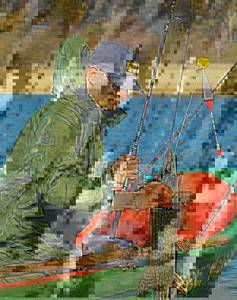
When choosing a fishing rod, keep in mind that its length should not exceed 3.5-4 meters. This has a big role when playing fish;
As for the reel, it is better to use a model that allows you to release the line in case of a bite. This is explained by the weakening of tension and pronounced tension of the fishing line, which increases the chance of successful hooking. Thus, the predator will be able to swallow the offered bait well in the place with the hook.
But the practice of using a rod without a reel is not recommended. By doing this, you will only greatly increase the risk of your gear breaking or your bait being spit out by a predator.
Attention must also be paid when choosing a float. For example, this concerns the ability to stay on the mirror surface of water. First of all, it must provide minimal, additional resistance in the event of a bite. At the same time, good bait retention must be ensured.
Therefore, if you wanted to use a Light Float for this purpose, give up this idea. Even a small, weakened baitfish will be able to drown it or simply lead it into an area with snags and dense thickets of algae. A snag is inevitable here.
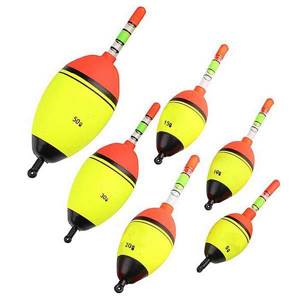
Catching pike with a float does not involve the use of an overly heavy bite alarm. Pike, when attacking live bait, may feel strong resistance and become wary. In most cases, she will refuse the bait.
For this reason, the best option for an angler would be to use an egg-shaped float. Various modifications of it can be found in almost any fishing store.
Regarding leashes (as noted above), it is worth saying the following - they must be strong without the slightest “BUT”. This is why it is customary to use their Kevlar and Metal versions. They are guaranteed to eliminate the negative impact of contact with pike teeth.
Only the presence of such leashes will allow you to successfully catch Pike with live bait and not worry about a possible escape.

You can use a braided fishing line with a diameter of about 0.2 mm. Although the usual 0.25 to 0.4 millimeters is quite suitable for this purpose.
And, of course, where would we be without Good, Sharp hooks. The priority is on the side of Tees, which ensure reliable capture of fish and minimal risk of slipping even when hooking a large specimen.
But this does not mean that Single and Double hooks should be completely abandoned. This is wrong. There is even a known method when anglers, when fishing with live bait, practice using 2 Single hooks with a bait hook in the tail and back area.
Promising Places for Fishing. Where to Fish for Pike?
Well, a natural question, especially for Beginner fishermen: “Where can I catch pike with float tackle, using live bait as bait?”
3 ways to improve your fish bite!
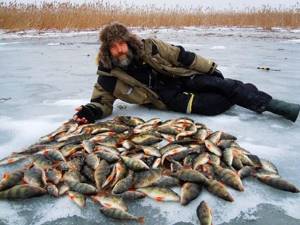
Over 15 years of active fishing, I have found many ways to improve the bite, and here are the most effective:
1. Bite activator . This pheromone additive attracts fish most strongly in cold and warm water. The Fish Hungry bite activator has proven itself to be excellent - Read more…
2. Tackle with increased sensitivity . You should first familiarize yourself with the features of using a particular type.
3. Pheromone baits . They attract the attention of fish, stimulate hunger and cause a schooling reflex, which allows you to collect a lot of fish in one place.
You can get the rest of the secrets of successful fishing for free by reading my other materials on the site.
3 ways to improve your fish bite!
Over 15 years of active fishing, I have found many ways to improve the bite, and here are the most effective:
1. Bite activator . This pheromone additive attracts fish most strongly in cold and warm water. The Fish Hungry bite activator has proven itself to be excellent - Read more…
2. Tackle with increased sensitivity . You should first familiarize yourself with the features of using a particular type.
3. Pheromone baits . They attract the attention of fish, stimulate hunger and cause a schooling reflex, which allows you to collect a lot of fish in one place.
You can get the rest of the secrets of successful fishing for free by reading my other materials on the site.
Here are Some of the Potentially Good Places Where Fishing for Pike with Live bait Will Bring Results:
River branches, Quiet backwaters or Oxbow lakes;
A strip of algae along the coastline on almost any body of water;
Wide river area with no or small current;
Open windows between algae and half-submerged driftwood. Here you, with a high degree of probability, will not be left without a catch. This is absolutely true.
Catching Pike on a Float. I haven't caught anything like this yet. Video
Catching pike perch on a donk with a spinning rod
Catching pike perch on a donka with a spinning rod is especially successful in the evening and at night. Live bait is used for bait.
When choosing a place to hunt, you need to know that pike perch can chase fry:
- at a depth;
- in the coastal zone.
Therefore, always take several tackles. And throw them to different parts of the reservoir. This will immediately increase your chances of success.
When biting, the main thing is not to be distracted:
- If the rod is bent, then the pike perch is hooked.
- When the rod is tense - a signal to hook.
Rod
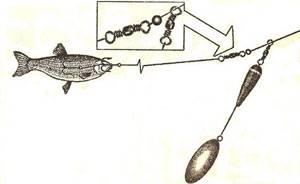
Bottom tackle consists of a powerful spinning rod and a spinning reel (power).
The reel is made from materials such as:
- high modulus carbon;
- fiberglass;
- metal
The main thing is that the tackle can be used to make a hard hook and pierce the bony jaw of the pike perch.
Rod characteristics:
- about four meters long;
- fishing line 0.3 – 0.4 mm;
- leash 0.26 mm;
- hooks No. 2 – 4;
- sliding sinker 30 - 40 g;
- it is advisable to equip it with a bell or a more effective - a modern bite alarm;
- swivel or American clasp.
If possible, you can add:
- anti-twist tube;
- triple swivel; or
- end sinker;
- a couple of leashes.
Select the fishing line based on:
- coil characteristics;
- the nature of fishing: the intensity of the current, the presence of snags, etc.;
- equipment weight.
Optional equipment
Experienced fishermen often prepare a rocker made of steel wire. The rocker arm is fixed to the fishing line, where the leash is tied. And it is already attached to the outlet. Here we covered the issue of a retractable leash for perch.
Advantages:
- the leash will not get tangled when casting;
- live bait in a brisk current will be able to play with a greater amplitude of movement.
Pike on donk
Catching pike with a rubber band takes a lot of time, even for experienced fishermen, due to the necessary preparation of gear and fishing location. And this is especially true for catching pike with an elastic band, without a special rod. Indeed, in such a situation, the entire length of the fishing line will be located on the ground, and when retrieving the catch, it will be necessary to be able not to tear it.
And in order to avoid troubles when preparing an elastic band for catching pike without a rod, it is important to pay attention to the following points:
- The fishing line should be located on a flat, cleared surface, without stones and grass, and it is best to fold it in rings, winding it clockwise;
- The fishing line is fixed at one end (when preparing equipment without a rod, you can tie the fishing line to the nearest bush or tree. And in the absence of vegetation and other similar objects on the shore, an ordinary wooden or iron peg will come to the rescue);
- The free edge of the fishing line is tied to the hook, and only then the bait is put on it (to the question of how to properly equip the bottom, it should also be added that the bait is selected depending on what predator will be hunted: perch, pike or carp. );
- When casting the bait, the sinker should be taken in one hand and the fishing line in the other, so that it can be controlled separately (it is recommended to cast the bait in a circular or pendulum motion).
Important! In the autumn, predatory fish become more active, and when swallowing bait, they will definitely try to drag it to the bottom. Therefore, you should select gear with special care and scrupulousness.
Having considered the option of how to make a donk without a rod, you can safely move on to the next question: the advantages of this type of fishing.
When catching predatory fish on a donk with a rubber shock absorber, you provide yourself with:
- Increased bait casting radius;
- Possibility of fishing in deep areas of the reservoir (where a standard spinning rod is not long enough);
- A short break while fishing (pike is very easy to catch with an elastic band, and at the same time, the tackle does not require constant supervision and control).
In order to cast a donkey over a long distance from the shore, you should equip it with the right fishing line (preferably nylon) in advance. Otherwise, you will not be able to catch the predator due to the line breaking, which can be caused by any stone or snag at the bottom of the reservoir.
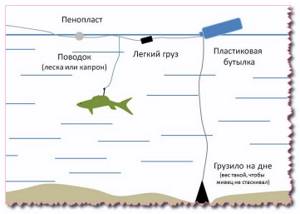
Catching pike perch on a predatory feeder
The pike perch is very prudent. Therefore, it is necessary to use only modern bite alarms and equipment, the resistance of which he can feel.
The feeder is primarily used for catching peaceful fish. Whereas a predatory feeder is designed for catching predatory fish . This is a fairly effective tackle.
Rod
Characteristics:
- Length 3-4 meters;
- test 100-120 gr.;
- Spinning reel series 3000 – 5000;
- Braid: 0.2 mm.
Initially, such rods were used for catching only non-predatory fish. But later, rods with ultra-sensitive tips began to be used for hunting pike perch.
Advantages:
- You can easily throw even heavy baits and over quite long distances.
- The sensitive tip will signal even minimal bites.
Can choose:
- hard tips;
- soft tops.
They are replaceable and attached to the top, the main thing is to follow the rules:
- The current is small - the tip is soft.
- big - hard.
Sinker
It is advisable to use equipment with a load sliding down. This ensures easy passage of the line through the sinker, without much resistance. When hunting over a rocky bottom or other obstacles, it is better to tie the sinker to a side leash.
And you definitely need to make sure that the sinker is thinner than the main fishing line . If it is otherwise, then a breakage cannot be avoided, even with a slight snag. An alternative solution to the problem: a load that has a through hole is placed on a side leash, which is secured with a toothpick.
Otherwise, the sinker will slide off the leash even with a small hook. If the bottom of the reservoir is very snarled, it is more advisable to take brass stick weights or lead ones. Thanks to their elongated shape, the number of hooks will be significantly reduced.
fishing line
It’s better to build a combined leash right away. The first 40 cm of the equipment is made standard. You need to take a non-standard fishing line (0.24 - 0.27 mm), and a thicker one. (0.40-0.60 mm.)
At the very end a “soft” leash is made:
- tungsten;
- 25 – 30 cm long.
It is equipped with a tee, but can be used with a double or single hook.
Feeder
The feeder is filled with standard bait, adding any chopped fish:
- capelin;
- pollock, etc.
You can also use live bait. This will attract walleye. The bait is attached to the feeder using a bait needle.
When mounting it outside the live bait, two small tees are inserted. This will allow you to make quick and effective hooking. The main thing is not to forget to take breaks. Between casts, at least half an hour should pass.
Advantages and disadvantages of using bottom gear
Such gear is designed for catching certain types of fish, including pike perch.
In general, there are 3 main methods of bottom fishing:
- Simple bottom fishing rod. In this case, you need to use a short and powerful rod. When installing the tackle, a relatively heavy sinker is installed and two or more leashes with hooks are attached to the main line. The weight of the sinker can reach 50 grams or more. In some cases, a sinker weighing up to 100 grams can be used. When casting, the hooks are caught at the very bottom. The disadvantage of this method is that you have to cast relatively often, and the noise from it can scare away the fish and it will simply go to a quieter place.
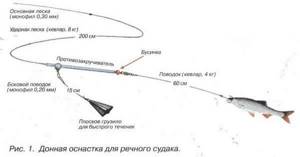
- The next way is fishing with an elastic band. It is not customary to use a fishing rod here. Usually the fishing line, tackle with hooks and feeder, and elastic band are pre-wound on the reel. On the first cast, the main line is directly attached to the elastic without using any gear at this point. A heavy weight is thrown into the desired place. Then the line is pulled back until an elastic band appears. After this, the tackle with leashes and a feeder is mounted, which is attached to the elastic band on one side by a swivel with a latch, and on the other side in the same way to the main fishing line. After this, the line is released - and the tackle goes under the water and ends up in the right place. The remaining part of the fishing line is wound on a reel, which is fixed to the ground. Such tackle disturbs the fish less when casting and contributes to more accurate casting of the tackle.
- The third method is to use a spinning rod with a reel . Both inertial and non-inertial coils can be used. The tackle is attached to the end of the main line along with leashes and a feeder. Then it is abandoned in the same way as in other similar cases.
It remains to emphasize the following. In each of these methods, fishing is possible both with and without a feeder. You can also fish from the shore or from a boat. In the latter case, the casting will be more accurate, and the safety of the bait will be better than when casting from the shore.
Another important characteristic property of bottom tackle is the use of a heavier sinker and relatively stronger fishing line. Usually they take one whose thickness is 0.35 mm or more.
pros
- This fishing method allows you to install fishing gear at different depths. This allows you to better match the habits of the fish in the relevant situation.
- You can fish or cast bait up to 80 meters. Thanks to this, you can fish from the shore not only close, but also at a sufficient distance.
- When bottom fishing, you can effectively use a bite alarm. Its signal will not allow you to miss bites even if you were not attentive enough or it was difficult to determine.
- Even when the weather is difficult (gusts of rain or strong wind), such an alarm will not allow you to miss a bite.
- Nothing prevents you from combining fishing and baiting. This significantly increases the chances of a good catch. Here we are talking not only about the feeder feeder, but also about additional bait.
Minuses
- Unfortunately, bottom fishing is not applicable everywhere. For example, on mountain rivers or in any places where there is a strong current or the bottom has a strong slope.
- Although the fact that the weight is located on the bottom, which allows some degree of adjustment of the height of the hooks, provides certain opportunities for the fisherman, this gear is not intended for fishing under the surface of the water.
- Where the bottom is heavily overgrown with algae, bottom tackle becomes much less effective.
- It can also be argued that the bottom, replete with snags, is also not suitable for such gear.
Catching pike perch with winter float tackle
First you need to drill or punch holes. They need to install and charge the vent. Holes are made in a chaotic order. Guessing where pike perch will appear is not easy.
Therefore, fishermen near the girder drill several holes, which are used for trolling. By doing this they provoke the pike perch into repeated attacks. How to make girders with your own hands, see another article on our website.
When biting, you need to take your time and wait:
- When the pike perch is hungry , it swallows the bait immediately and, having unwinded the entire fishing line, hooks itself.
- A well-fed pike perch may not immediately swallow the prey, but will swim for some time, holding it in its teeth. When you bite with a powerful, energetic movement, make a hook and the fish is yours!
Rod
A typical design looks like this:
- Line : 0.4 - 0.5 millimeters, with a margin of at least twenty meters.
- Leash 0.5 mm, made of special fishing line (30 - 40 cm).
- Lead pellet : attached in front of the leash for better fixation. Mounted with an easily sliding “olive”, weighing up to 30 g.
- Single hook No. 8, No. 12, you can also take double hook No. 5–7.
- The reel is 6 cm , it is better to use it with high sides (1.5–3 cm) and braking torque.
When biting, this device can prevent unnecessary line release. During installation, it is fixed with a spring made of wire or plate. It is brightly colored and has a signaling flag located at the very top.
A bait fish attached to a hook will not be able to remove the signaling device inserted behind the reel. But if a pike perch takes it, the flag will immediately shoot up! This is a simple tackle, quite effective.
Nutrition and lifestyle of pike perch
Pike perch is a predatory fish, so its menu consists of 80% small fish:
- roach;
- bleaks;
- minnow;
- perch;
- chub.
What kind of fish it will eat depends only on its habitat.
He does not refuse earthworms either. Fishing is especially good with them in the spring; you can catch quite large specimens.
Sometimes they find in his stomach:
- crustaceans;
- tadpoles;
- shellfish
He feeds especially intensively:
- before spawning;
- after spawning;
- late autumn.
He feeds at any time:
- Especially greedily - at dawn.
- In spring and early summer - prefers daytime feeding.
- By the end of summer it switches to a nocturnal lifestyle.
During the daytime, pike perch rarely approaches the shore. Favorite habitats: driftwood, stones, etc. at a depth of 3 - 5 meters. Hiding behind shelters, they lie in wait for their prey.
They reach sexual maturity at the age of three. In the spring, when the water warms up to 10 ºС, spawning begins. They prefer only clean water and do not settle in dirty water. They live in southern territories and water bodies in the middle zone. Not found in Northern rivers.
Catching pike perch with a donkey at different times of the year
Throughout the year, the activity of the predator changes noticeably, so each season requires a special approach to the “fanged one.” Undoubtedly, pike perch is primarily a nocturnal predator, but it can also go out to feed during the daytime, depending on weather conditions, temperature, pressure and seasonal characteristics.
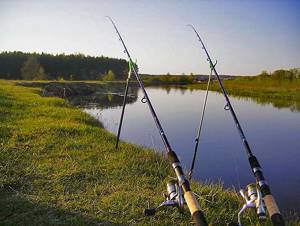
The pike perch bite resembles a regular roach. Small twitches and movement of the rod tip indicate that the predator is interested in the bait. You should only hook with a good pull, otherwise you may miss the prey.
Spring
The pre-spawning feast does not last long, and when the water temperature reaches 11-12 °C, the bite subsides, and the individuals go to shallow water, where spawning occurs. Fishing is prohibited at this time.
In spring, the predator does not disdain large bait, such as roach or rudd. Pike perch has a narrow mouth, so live bait is selected according to this parameter. Live bait performs much better in terms of the number of bites than dead or artificial bait. At this time, you need to look for the “fanged one” at depths of 3 meters. In early spring, anglers note fish activity throughout the day, but closer to summer it becomes periodic: a couple of hours in the morning and evening, before sunset.
Summer
With the first real warmth and the temperature reaching 25-30°C, the fish move to deeper places. Sunny days bring weak results, unlike cloudy days.
Promising points to search for the “fanged”:
- channel edges;
- dumps from shallow water to depth;
- elevations on pits (so-called tables);
- sharp turns of rivers and places under steep banks.
How to increase your pike perch catch?
There are many ways to increase fish catch, but we will focus on the most effective:
- Bite activator : this is a natural pheromone additive that attracts fish from long distances. She's safe. But Rosprirodnadzor wants to completely ban the sale of the bite activator, because the catch with its help increases significantly, and this will negatively affect the population.
- Increase the sensitivity of the gear.
- Pheromone lures.
Fishing with live bait is an ancient method, suggested by nature itself. Moreover, you can fish with the most primitive gear. The most skillful imitation of bait can never compare with live bait. The attack of a toothy predator and the fight against it cannot be compared with anything!
How to catch pike on a donk?
In order to catch a predatory fish with live bait, the fisherman just needs to occupy the correct location where the object of his hunt lives, and also not disdain the parameters of the reservoir described above. After confirming your choice, the fishing technique involves placing bait on the hook.
The fish that acts as bait should be hooked through the mouth in such a way that it holds very tightly, and even if it gets caught in algae, it cannot fall off the gear. Well, then it’s just a matter of little things: throw the donkey to the depth you need, and just wait for the bite.
